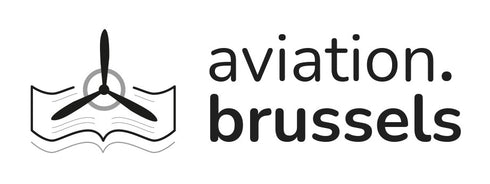[CLASSIC] N°20 FOCKE-WULF Fw190 1944 - 1945 Volume Three
![[CLASSIC] N°20 FOCKE-WULF Fw190 1944 - 1945 Volume Three](http://aviation.brussels/cdn/shop/files/IMG_7570_d495bf0b-9f54-4929-a738-9263180ae833_92x92_crop_center.jpg?v=1728144559)
![[CLASSIC] N°20 FOCKE-WULF Fw190 1944 - 1945 Volume Three](http://aviation.brussels/cdn/shop/files/IMG_7571_15cf9584-85df-41f3-b17e-1e7923b39903_92x92_crop_center.jpg?v=1728144559)
![[CLASSIC] N°20 FOCKE-WULF Fw190 1944 - 1945 Volume Three](http://aviation.brussels/cdn/shop/files/IMG_7574_f13fdf52-9980-45d1-bdb1-617843daaea3_92x92_crop_center.jpg?v=1728144558)
![[CLASSIC] N°20 FOCKE-WULF Fw190 1944 - 1945 Volume Three](http://aviation.brussels/cdn/shop/files/IMG_7575_737bc824-07eb-4343-9b79-062f2bbe39f8_92x92_crop_center.jpg?v=1728144559)
![[CLASSIC] N°20 FOCKE-WULF Fw190 1944 - 1945 Volume Three](http://aviation.brussels/cdn/shop/files/IMG_7576_92x92_crop_center.jpg?v=1728144558)
![[CLASSIC] N°20 FOCKE-WULF Fw190 1944 - 1945 Volume Three](http://aviation.brussels/cdn/shop/files/IMG_7577_92x92_crop_center.jpg?v=1728144559)
![[CLASSIC] N°20 FOCKE-WULF Fw190 1944 - 1945 Volume Three](http://aviation.brussels/cdn/shop/files/IMG_7578_5b9b81c0-6274-4b1f-b1cf-e20e7cdd5780_92x92_crop_center.jpg?v=1728144559)
![[CLASSIC] N°20 FOCKE-WULF Fw190 1944 - 1945 Volume Three](http://aviation.brussels/cdn/shop/files/IMG_7579_92x92_crop_center.jpg?v=1728144558)
![[CLASSIC] N°20 FOCKE-WULF Fw190 1944 - 1945 Volume Three](http://aviation.brussels/cdn/shop/files/IMG_7580_1c90f21f-25fa-492e-8687-30d83a468d35_92x92_crop_center.jpg?v=1728144559)
Prix régulier 300,00 € TTC 6%
Characteristics
| Book cover finish | Hardcover ( square back binding ) |
| Special features | Dust jacket |
| Condition | Used good |
| Published date | 2013 |
| Language | English |
| Collection / Series | CLASSIC |
| Author | J. Richard Smith & Eddie J. Creek |
| Editor | Ian Allan Publishing |
Description
In this, the third volume of the trilogy which Aeroplane magazine has described as "certainly the definitive work on the Fw 190 so far," Luftwaffe historians J. Richard Smith and Eddie J. Creek turn to the final phases of the Second World War and the crucial role that the Fw 190 played in defending the airspace over the Third Reich, as well as its part in the great battles on the Eastern Front from the summer of 1944.
When Allied forces landed in France in June of that year to launch the invasion of north-west Europe, the Luftwaffe fielded just over 100 Focke-Wulf fighters, ground-attack, and reconnaissance machines to repel them. This figure was drastically increased as the Luftwaffe reacted to the danger in Normandy, transferring units from the Reich. From that point on, and for the next eleven months, German pilots fought some of their most bitter and intense air battles over the Western Front as they attempted to hold back the Allied advance through France, Belgium, Holland, and into Germany itself.
To the south, in Italy, the Luftwaffe deployed the Fw 190 to attack Allied convoys in the Mediterranean, while from Macedonia, Focke-Wulf were used to cover the German retreat from Greece. Later, as the Allied armies advanced through Italy, more aircraft were deployed in the nocturnal fighter and ground-attack roles.
But perhaps some of the most epic encounters took place between the Jagdgruppen and the heavy bombers of the USAAF as the Allied strategic bomber offensive struck at targets all over occupied Europe and the Reich itself. This was a draining, attritional mission, but one which nevertheless took its toll on the bombers. The Fw 190 was upgraded to include heavier armor and high-caliber weapons for close-range operations – so-called Sturmjäger (assault fighters) – against the four-engined heavy bombers, which came fortified with strong defensive armament and fighter escort. As one Fw 190 pilot recalled: "The outlook in store for us on each mission was frightening and awful. However, when the US escort fighters could not get to us, we were sure to cause some serious damage among the bombers."
Simultaneously, in the second half of 1944, in the East, Fw 190 units battled to stem the "Red tide" across a vast front stretching from Finland, Latvia, and northern Russia to Ukraine. But eventually, the central sector of the German defensive line gave way, and the Wehrmacht began a retreat through Poland, Hungary, and Romania. Using bombs and new anti-tank rocket projectiles, the Fw 190-equipped Schlachtgruppen performed well against Soviet armor, but it was often a story of "too little, too late." Against an enemy superior in numbers, losses inevitably climbed both among veteran unit commanders and among younger, less experienced pilots in units suffering from shortages in fuel, ammunition, and spares.
Despite the reversals which Axis forces suffered from late 1944 onwards, this was a time of considerable technological advances in aviation design, not least of which related to the Fw 190 and its engines and armament. The authors describe the introduction of the "long-nosed" Fw 190 D-9, which, with its high-performance Jumo 213 engine, was intended to engage heavy bombers at higher altitudes. Also covered are the later 'D' variants and the progressive development in BMW and Jumo engines, as well as new designs in special weapons such as upward-firing batteries, heavy-caliber armament, and rockets. Also included in this volume are appendices which include exhaustive data on Fw 190 pilot losses, prototypes, and production variants.
The authors have researched the Fw 190 for more than 35 years and have assembled an unrivaled archive of documents, manufacturers' manuals, drawings, and photographs.
With hundreds of photographs, drawings, and specially commissioned color artwork, this study is the key reference work.
Source: Publisher's summary printed on cover

![[CLASSIC] N°20 FOCKE-WULF Fw190 1944 - 1945 Volume Three](http://aviation.brussels/cdn/shop/files/IMG_7570_d495bf0b-9f54-4929-a738-9263180ae833_{width}x.jpg?v=1728144559)
![[CLASSIC] N°20 FOCKE-WULF Fw190 1944 - 1945 Volume Three](http://aviation.brussels/cdn/shop/files/IMG_7571_15cf9584-85df-41f3-b17e-1e7923b39903_{width}x.jpg?v=1728144559)
![[CLASSIC] N°20 FOCKE-WULF Fw190 1944 - 1945 Volume Three](http://aviation.brussels/cdn/shop/files/IMG_7574_f13fdf52-9980-45d1-bdb1-617843daaea3_{width}x.jpg?v=1728144558)
![[CLASSIC] N°20 FOCKE-WULF Fw190 1944 - 1945 Volume Three](http://aviation.brussels/cdn/shop/files/IMG_7575_737bc824-07eb-4343-9b79-062f2bbe39f8_{width}x.jpg?v=1728144559)
![[CLASSIC] N°20 FOCKE-WULF Fw190 1944 - 1945 Volume Three](http://aviation.brussels/cdn/shop/files/IMG_7576_{width}x.jpg?v=1728144558)
![[CLASSIC] N°20 FOCKE-WULF Fw190 1944 - 1945 Volume Three](http://aviation.brussels/cdn/shop/files/IMG_7577_{width}x.jpg?v=1728144559)
![[CLASSIC] N°20 FOCKE-WULF Fw190 1944 - 1945 Volume Three](http://aviation.brussels/cdn/shop/files/IMG_7578_5b9b81c0-6274-4b1f-b1cf-e20e7cdd5780_{width}x.jpg?v=1728144559)
![[CLASSIC] N°20 FOCKE-WULF Fw190 1944 - 1945 Volume Three](http://aviation.brussels/cdn/shop/files/IMG_7579_{width}x.jpg?v=1728144558)
![[CLASSIC] N°20 FOCKE-WULF Fw190 1944 - 1945 Volume Three](http://aviation.brussels/cdn/shop/files/IMG_7580_1c90f21f-25fa-492e-8687-30d83a468d35_{width}x.jpg?v=1728144559)

